Hello, I’m excited to share with you some tips on creating and caring for tropical indoor plants. Adding tropical plants to your home not only enhances the aesthetics but also purifies the air, creating a serene and relaxing environment. From philodendrons to ferns, there are a variety of exotic house plants that thrive indoors and require minimal maintenance.
To create your very own tropical oasis, it’s important to understand the care requirements of indoor tropical plants. Proper watering, providing adequate light and humidity, and fertilizing during the growing season will ensure their health and vibrancy. Let’s dive into the details of how to care for these beautiful plants and bring a touch of the tropics into your home.
Key Takeaways:
- Transform your living space into a tropical oasis with lush, vibrant indoor plants.
- Exotic house plants not only enhance aesthetics but also purify the air.
- Proper watering, light, humidity, and fertilization are key to caring for tropical plants.
- Common problems include yellow leaves, drooping, and browning tips.
- Tropical plants add color, life, and a calming atmosphere to any room.
Before We get into any specific topics I thought I would give you some quick reference to pick your desirable tropicals to begin your indoor oasis.
Common Name | Care | Light | Water | Humidity | Growth | Temp. | Toxicity |
Swiss Cheese Plant | Mod | Bright, indirect | Regular | High | Fast, large | Warm | Mild |
Fiddle Leaf Fig | Mod | Bright | Moderate | Moderate | Slow, tall | Warm | Mild |
Anthurium | Mod | Bright, indirect | Regular | High | Moderate | Warm | Toxic |
Philodendron | Easy | Moderate | Regular | Moderate | Varies | Warm | Toxic |
Bird of Paradise | Mod | Bright | Regular | High | Fast, large | Warm | Mild |
Peace Lily | Easy | Low to Moderate | Regular | High | Moderate | Warm | Toxic |
Areca Palm | Mod | Bright, indirect | Regular | High | Moderate | Warm | Non-toxic |
Bromeliads | Easy | Moderate | Low | High | Slow | Warm | Varies |
Elephant Ear Plant | Mod | Bright, indirect | Regular | High | Fast, large | Warm | Toxic |
ZZ Plant | Easy | Low | Low | Moderate | Slow | Moderate | Toxic |
Orchids | Hard | Moderate | Low | High | Slow | Warm | Varies |
Pothos | Easy | Low | Moderate | Moderate | Fast | Moderate | Toxic |
Dracaena | Easy | Moderate | Moderate | Moderate | Moderate | Warm | Toxic |
Calathea | Mod | Low | Regular | High | Moderate | Warm | Non-toxic |
Spider Plant | Easy | Moderate | Regular | Moderate | Fast | Moderate | Non-toxic |
Croton | Hard | Bright | Regular | High | Slow | Warm | Toxic |
Snake Plant | Easy | Low | Low | Low | Slow | Moderate | Mild |
Rubber Plant | Easy | Moderate | Regular | Moderate | Fast, large | Warm | Toxic |
Parlor Palm | Easy | Low | Regular | Moderate | Slow, small | Moderate | Non-toxic |
Kentia Palm | Easy | Moderate | Regular | Moderate | Slow, tall | Moderate | Non-toxic |
*Care: Easy (Easy), Mod (Moderate), Hard (Hard) *Temp.: Temperature preference *Toxicity: Toxicity level to pets/humans (Non-toxic, Mild, Toxic)
This format provides essential care information that gardeners typically seek when selecting and maintaining tropical house plants.
Watering Your Plant
Watering is a crucial aspect of caring for tropical indoor plants. Proper watering ensures that plants receive enough water without being overwatered, promoting their healthy growth. Here are some key points to keep in mind when watering your tropical plants:
- Check the moisture level of the soil: One way to determine if your plant needs watering is by checking the top inch or two of soil. If it feels dry to the touch, it’s time to water your plant.
- Drainage is important: When watering your tropical plant, make sure to check the drainage holes in the pot. Standing water at the bottom of the pot is a sign of excessive water, which can lead to root rot. If there’s excess water, allow it to drain out completely.
- Use lukewarm tap water: It’s best to use lukewarm tap water when watering your tropical plants. Cold or chlorinated water can shock the plants and cause damage. Allow the water to sit for a day or two before using it to allow any chlorine to dissipate.
Remember, each plant has its watering needs, so it’s important to research and understand the specific requirements of your tropical plants. By providing them with the right amount of water, you’ll help them thrive and create a lush, tropical oasis in your home.
Light & Humidity
When it comes to caring for tropical indoor plants, providing the right amount of light and humidity is key. Most tropical plants thrive in bright indirect sunlight, meaning they need plenty of light throughout the day without the direct rays of the sun. Placing your plants near a window where they can receive ample natural light is ideal. If direct sunlight is unavoidable, you can use sheer curtains or blinds to filter the light and prevent any damage to the plants.
Adequate humidity is also essential for the well-being of tropical plants. These plants are accustomed to high humidity levels in their natural habitat, so it’s important to recreate those conditions indoors. If the humidity level in your home drops below 60%, your plants may suffer. One way to increase humidity is by misting the plants with a spray bottle. Do this every few days to provide the plants with a moisture boost. Another option is to use a humidifier to maintain the ideal humidity level.
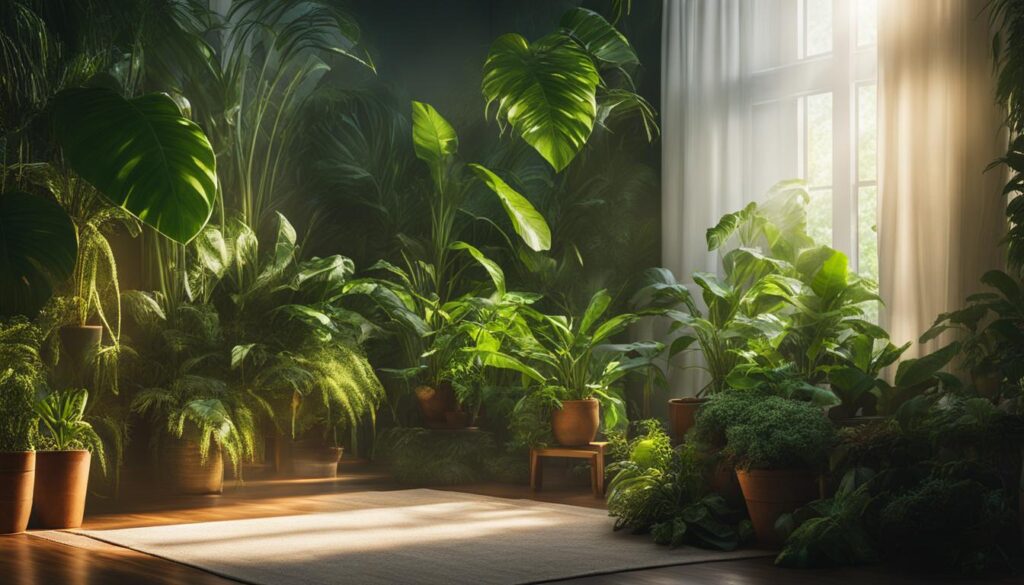
Creating the right conditions of light and humidity ensures that your tropical plants not only survive but thrive in your indoor space. With optimal care, these lush green beauties will add a touch of nature and a tropical vibe to your home decor.
Fertilizing Your Plant
Proper fertilization is essential for the growth and health of tropical foliage plants. Fertilizers provide the necessary nutrients that plants may not receive from the soil alone. When it comes to fertilizing your indoor tropical plants, it’s important to choose the right type of fertilizer that is specifically formulated for indoor plants. Outdoor fertilizers often contain excessive amounts of nitrogen, which can harm your plants.
Opt for a balanced fertilizer with equal amounts of nitrogen (N), phosphorus (P), and potassium (K), such as a 10-10-10 or 20-20-20 blend. This will provide a well-rounded nutrient mix to support the overall growth and development of your tropical foliage plants.
When and How to Fertilize
During the growing season, which typically occurs in spring and summer, it is recommended to fertilize your tropical foliage plants once a month. This ensures they receive a consistent supply of nutrients to support their growth and lush foliage.
To fertilize your plants properly, follow these steps:
- Prepare the fertilizer according to the package instructions, either by diluting it with water or using it directly.
- Gently water the soil around the base of each plant to moisten it before applying the fertilizer. This prevents any potential root burn.
- Apply the fertilizer evenly, following the recommended dosage on the package. Avoid over-fertilizing, as this can cause nutrient imbalances and damage the plant.
- After applying the fertilizer, water the plants again to allow the nutrients to penetrate the soil and reach the roots.
Remember to always read and follow the manufacturer’s instructions on the fertilizer package for best results.
| Fertilizing Your Tropical Foliage Plants: Do’s and Don’ts |
|---|
| Do: |
| – Choose a balanced fertilizer specifically formulated for indoor plants. |
| – Use a fertilizer with equal amounts of nitrogen, phosphorus, and potassium. |
| – Fertilize once a month during the growing season. |
| – Follow the package instructions for dosage and application. |
| Don’t: |
| – Over-fertilize, as this can harm the plants. |
| – Use outdoor fertilizers, which may contain excessive amounts of nitrogen. |
Remember, fertilizing is just one aspect of caring for your tropical foliage plants. Providing adequate light, regular watering, and maintaining the right humidity levels are equally important for their overall well-being.

By following proper fertilization practices along with other care guidelines, you can enjoy healthy, vibrant tropical foliage plants that bring a touch of the tropics to your indoor space.
Troubleshooting Common Problems
Tropical plants, like any other living organisms, can experience issues that affect their overall health and appearance. It’s important to identify and address these problems promptly to ensure the well-being of your beloved plants. In this section, I will discuss some common problems that tropical plants may encounter and provide tips to troubleshoot and resolve them.
Yellow Leaves on Tropical Plants
One common issue that tropical plants may face is the development of yellow leaves. Yellowing leaves can be indicative of watering problems, either too much or too little. To address this issue, you need to adjust your watering practices accordingly.
Quote: “Yellow leaves on tropical plants can be a sign of watering issues. It’s important to find the right balance to maintain their optimal health.” – Me
If the soil is consistently wet and the leaves are turning yellow, it may be a sign of overwatering. In this case, reduce the frequency of watering and allow the soil to dry out slightly before watering again.
On the other hand, if the soil is dry and the leaves are turning yellow, it may indicate insufficient watering. In this case, increase the frequency of watering and ensure that the soil is adequately moist, but not waterlogged.
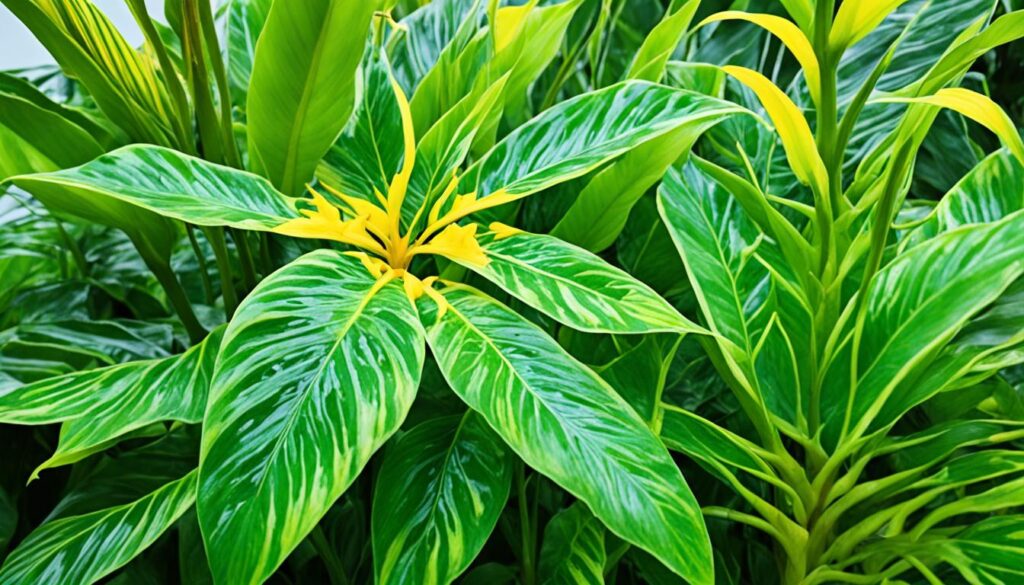
Drooping Leaves on Tropical Plants
Another problem that tropical plants may experience is drooping leaves. Drooping leaves can be caused by various factors, including insufficient sunlight or overwatering.
If your tropical plants are not receiving enough sunlight, you may need to reposition them to a location where they can receive more indirect light. Placing them near a window or using grow lights can help provide the necessary light for their growth.
In the case of overwatering, the waterlogged soil can lead to drooping leaves. To address this issue, you may need to repot your plants using well-draining soil or adjust your watering schedule to prevent excessive moisture.
Brown Tips on Tropical Plants
Brown tips on the leaves of tropical plants are typically a sign of overwatering or alkaline soil. To alleviate this problem, it’s important to take appropriate actions.
If you suspect overwatering is causing brown tips, adjust your watering practices to ensure that the soil is not overly saturated. Allow the soil to dry out slightly between waterings.
In the case of alkaline soil, repotting your plants using acidic soil specifically formulated for tropical plants can help balance the pH levels and prevent further browning of the tips.
By addressing these common problems and taking appropriate actions, you can ensure the health and beauty of your tropical plants. Remember to regularly monitor your plants for any signs of distress and provide them with the care they need to thrive.
Benefits of Tropical Plants
Adding tropical plants to your home offers numerous benefits. They contribute to improved air quality by removing toxins from the air, making the indoor environment healthier. Additionally, tropical plants have been shown to reduce stress levels and create a calming atmosphere. They also add color and life to any room, providing an instant facelift to the space.
Tropical plants can create a tropical oasis indoors, regardless of the weather outside. Moreover, the wide variety of tropical plant species allows for different styles of decorating, adding interest and uniqueness to any room.
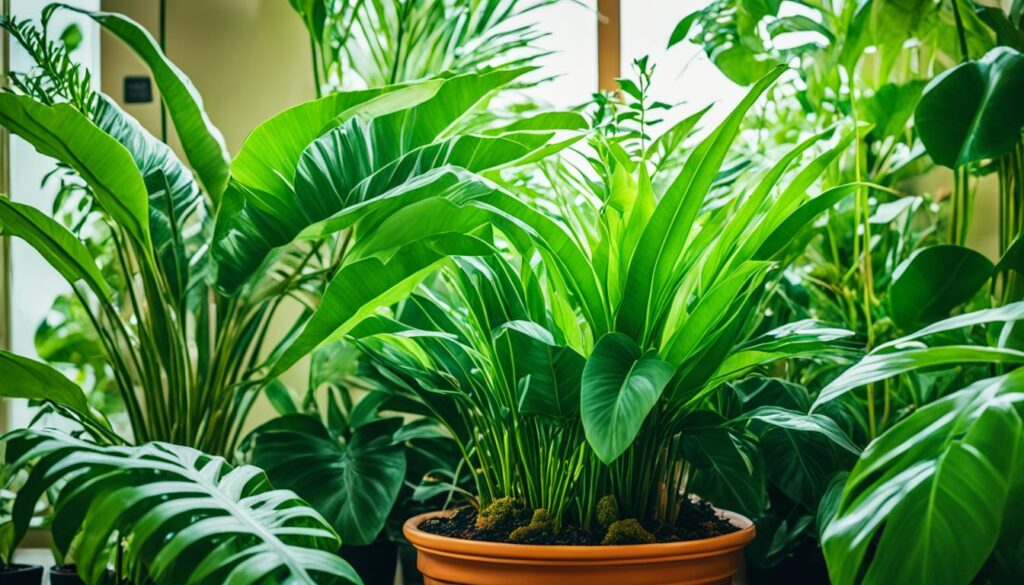
Choosing the Right Tropical Plants
Selecting the perfect tropical plants for your indoor space requires careful consideration. To ensure a harmonious fit, begin by evaluating the size of the plants in relation to the available space. Proportionate plants create an aesthetically pleasing arrangement and prevent overcrowding.
Understanding the light requirements is crucial, as tropical plants thrive in abundant sunlight. Find a spot in your home where they can bask in the warmth and brightness without direct exposure to the sun’s harsh rays.
When choosing tropical plants, it’s important to consider their water requirements. These plants generally crave more moisture and humidity. Be prepared to provide the proper watering regimen and create a humid environment, either by misting the leaves or using a humidifier.
Tropical plants prefer warmer temperatures. Make sure your indoor environment offers a comfortable climate for these plants to flourish.
Researching the wide range of tropical plant options available will help you find the perfect plant that aligns with your needs, preferences, and lifestyle. Take your time to explore different species, their care requirements, and their unique features to create an indoor tropical oasis that brings joy and serenity to your home.
Top 10 Tropical Plants to Grow Indoors
There are numerous tropical plants that are well-suited for indoor growth. Here are ten popular choices:
- Ficus: The Ficus plant, also known as the Weeping Fig, is a popular choice for indoor gardens. It has beautiful foliage and can thrive in various light conditions.
- Dracaena: With its striking sword-shaped leaves, the Dracaena adds a touch of elegance to any indoor space. It is known for its air-purifying qualities.
- Philodendron: The Philodendron is a versatile plant that comes in various sizes and shapes. It is easy to care for and can adapt well to different light conditions.
- Areca Palm: The Areca Palm is a tropical beauty with feathery fronds that add a touch of elegance to any room. It thrives in bright, indirect light.
- Boston Fern: Known for its lush green foliage and cascading fronds, the Boston Fern is a classic choice for adding a touch of nature indoors. It loves high humidity.
- Peace Lily: The Peace Lily is prized for its beautiful white flowers and glossy green leaves. It is known for its ability to purify the air.
- Caesalpinia: Also known as the Bird of Paradise plant, the Caesalpinia features vibrant, striking flowers that resemble a tropical bird. It requires bright light to bloom.
- Chamaedora Elegans: Commonly known as the Parlor Palm, this graceful plant adds a touch of elegance to any room. It thrives in low to medium light conditions.
- Schefflera Amate: With its glossy, palmate leaves, the Schefflera Amate is a popular choice for adding a tropical touch to indoor spaces. It prefers bright, indirect light.
- Alocasia Amazonica: The Alocasia Amazonica, also known as the Elephant Ear plant, features large, striking leaves with bold patterns. It thrives in bright, indirect light.
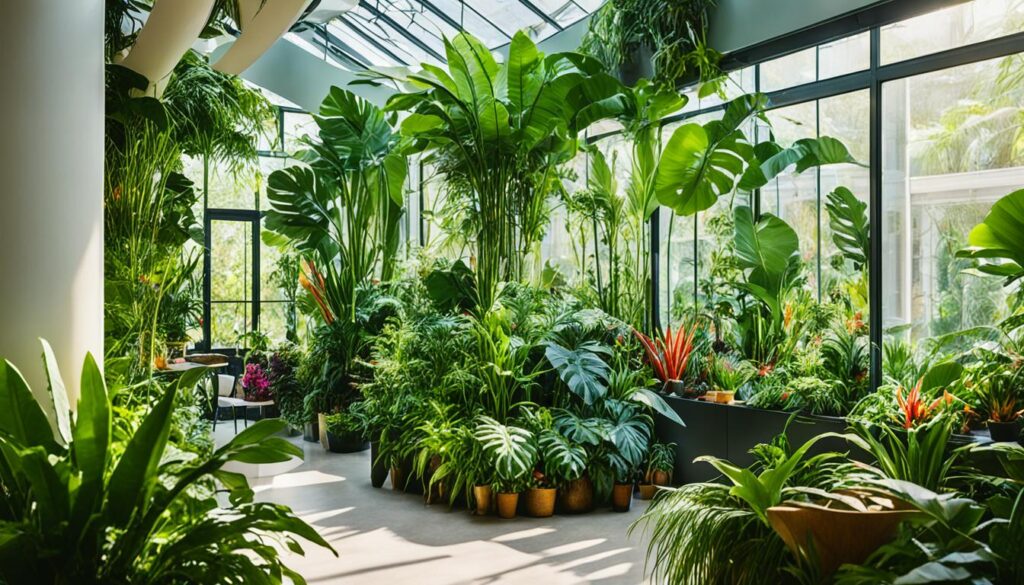
“Adding these tropical plants to your indoor space will not only beautify your home but also create a relaxing and refreshing atmosphere.”
How to Take Care of Tropical Plants
Proper care is essential to ensure the optimal growth and health of tropical plants. As an avid plant lover, I have learned some valuable tips and techniques for caring for tropical indoor plants. In this section, I will share my insights on watering, light and humidity requirements, fertilization, troubleshooting common problems, regular maintenance tasks, and understanding specific care requirements for different tropical plant species.
Watering Your Tropical Plants
When it comes to watering tropical plants, it’s important to strike the right balance. Overwatering can lead to root rot, while underwatering can cause the plants to wilt and suffer. A general rule of thumb is to water your plants when the top inch or two of soil feels dry. It’s also a good idea to check the drainage holes in the pot to ensure that excess water can escape.
“”Watering is a crucial aspect of caring for tropical indoor plants. It is important to ensure that the plants receive enough water without being overwatered.””
Remember, tropical plants typically prefer slightly moist soil, so it’s better to underwater than overwater. Using lukewarm tap water is recommended, as cold or chlorinated water can shock the plants and cause damage.
Light and Humidity Requirements
Most tropical indoor plants thrive in bright, indirect sunlight. It’s best to place them near windows or in well-lit areas of your home. However, direct sun exposure can scorch their leaves, so it’s important to find the perfect balance. Additionally, tropical plants require adequate humidity to thrive. If the humidity level in your home drops below 60%, you can mist the plants with a spray bottle or use a humidifier to maintain the ideal moisture level.
Fertilizing Your Tropical Plants
Fertilizing is an essential part of tropical plant care. As the plants grow, they need a steady supply of nutrients to stay healthy and vibrant. I recommend using a balanced, water-soluble fertilizer specifically formulated for indoor plants. During the growing season, which is usually spring and summer, fertilize your plants once a month. Be cautious not to over-fertilize, as it can lead to nutrient burns and damage the plants.
Troubleshooting Common Problems
Even with proper care, tropical plants can encounter some common problems. Yellow leaves can be a sign of overwatering or underwatering, while drooping leaves may indicate insufficient light or overwatering. If you notice these issues, adjust your watering schedule or reposition the plants to a brighter location. Brown tips on the leaves usually result from over-fertilizing or alkaline soil. Correcting the fertilizer dosage or using acidic soil can help alleviate this problem.
Regular Maintenance Tasks
To keep your tropical plants in optimal condition, regular maintenance tasks are necessary. Cleaning the leaves with a damp cloth or spraying them with water removes dust and allows the plants to breathe. Pruning any yellow or dead leaves helps redirect energy to healthy growth. It’s also essential to regularly inspect your plants for pests and take appropriate action if any infestation is detected.
Understanding Care Requirements for Different Tropical Plant Species
Each tropical plant species has its own specific care requirements. It’s important to research and understand the specific needs of the plants you have in your collection. Some tropical plants prefer more sunlight, while others thrive in lower light conditions. Different plants may have different watering needs or specific temperature requirements. By gaining knowledge about your tropical plants, you can provide the best care and ensure their overall well-being.
With the right care and attention, your tropical indoor plants will thrive, adding beauty and a touch of nature to your home. Stay tuned for the next section, where I will provide valuable insights into the light and soil requirements for tropical plants.
| Watering | Light & Humidity | Fertilizing | Troubleshooting | Maintenance | Understanding Care Requirements |
|---|---|---|---|---|---|
| Proper watering is crucial for tropical plants. Avoid overwatering and underwatering. | Provide bright indirect sunlight and maintain adequate humidity levels. | Fertilize once a month during the growing season with a balanced fertilizer. | Troubleshoot common problems like yellow leaves, drooping leaves, and brown tips. | Regularly clean the leaves, prune dead or yellow leaves, and check for pests. | Research and understand the specific care requirements of each tropical plant species. |
Light and Soil Requirements for Tropical Plants
When it comes to caring for your indoor tropical plants, providing the right light and soil conditions is crucial for their growth and well-being. Most tropical plants thrive in bright, indirect light, making them perfect for areas with ample natural sunlight that is not directly exposed. Whether you place them near windows or use artificial lighting, ensuring they receive enough light is essential for their development.
In terms of soil, tropical plants have specific requirements to maintain their health. They need a well-draining soil that holds moisture without becoming waterlogged. This allows the roots to breathe and prevents the risk of root rot. To meet these needs, it’s recommended to choose a high-quality potting mix specifically formulated for indoor plants.
Here are some key points to keep in mind:
- Place your tropical plants in locations with bright, indirect light.
- Consider using artificial lighting if natural light is insufficient.
- Use a well-draining potting mix formulated for indoor plants.
By ensuring your indoor tropical plants receive the right amount of light and are potted in suitable soil, you will provide them with optimal conditions for growth and help them thrive in your home environment.
Proper Care for Tropical Houseplants
Taking care of tropical houseplants is essential to ensure their well-being and longevity. By following a few simple practices, you can create an optimal environment for your indoor tropical plants and help them thrive.
Avoid Dryness
One important aspect of caring for tropical houseplants is to avoid placing them near drafts or vents that can cause dryness. These plants originate from tropical regions where humidity is higher, so it’s crucial to provide them with a suitable environment.
Watering
When it comes to watering your tropical houseplants, it’s important to find the right balance. Check the top inch of soil and water your plants when it feels dry. However, be cautious not to overwater them, as this can lead to root rot and other issues.
Misting for Humidity
Tropical plants thrive in humid environments. If you live in a dry climate or during periods of low humidity, regularly misting your plants can help increase the humidity levels around them. This can be done using a spray bottle filled with clean water.
Fertilizing
Feeding your tropical houseplants with a diluted fertilizer specifically designed for tropical plants is important for their growth and overall health. Follow the instructions on the fertilizer packaging to ensure you provide the right nutrients in the right quantities.
Leaf Cleaning
Periodically cleaning the leaves of your tropical houseplants helps remove dust, allowing them to absorb more light and maintain their health. Take a damp cloth or sponge and gently wipe each leaf to keep them clean and free from debris.
| Proper Care Tips for Tropical Houseplants |
|---|
| Avoid placing the plants near drafts or vents that can cause dryness. |
| Water your plants when the top inch of soil feels dry, but avoid overwatering. |
| Mist your plants regularly to increase humidity in dry environments. |
| Feed your plants with a diluted fertilizer specifically designed for tropical plants. |
| Periodically clean the leaves of your plants to remove dust and debris. |
Conclusion
Caring for and growing tropical plants indoors can bring beauty, freshness, and a touch of nature to any home. By following proper care guidelines, such as watering appropriately, providing sufficient light and humidity, and fertilizing regularly, you can create a thriving indoor tropical garden. These tropical plant care tips will help ensure the health and vibrancy of your indoor tropical plants, allowing them to flourish and add a delightful ambiance to your living space.
Understanding the specific needs of each tropical plant species is crucial for their well-being. Troubleshooting common issues, such as yellow leaves or drooping, will help you address any problems promptly and keep your plants healthy. Remember to regularly clean the leaves, prune when necessary, and monitor their growth to ensure optimal conditions.
With the right care and attention, your indoor tropical plants will reward you with their lush foliage, vibrant colors, and air-purifying benefits. Whether you choose philodendrons, ferns, or orchids, the beauty of these indoor tropical plants will transform your home into a tropical oasis. Embrace the joy of tropical plant care and enjoy the serenity and natural beauty they bring to your indoor space.
For Fun and Peaceful setting with tropical houseplants and more stop by our shop at The Landscape Connection and for fun video content please visit our YouTube Channel @GardeningWith The Landscape Connection
FAQ
How often should I water my tropical plants?
It is recommended to water tropical plants when the top inch or two of soil feels dry.
How can I tell if I am overwatering my tropical plants?
Check the drainage holes in the pot. If there is standing water at the bottom, it indicates excessive watering.
What type of water should I use to water my tropical plants?
It is best to use lukewarm tap water for watering, avoiding cold or chlorinated water that can shock the plants.
Where should I place my tropical plants in terms of lighting?
Tropical plants prefer bright indirect sunlight, so it is best to place them in a location where they receive plenty of light throughout the day but not direct sun exposure.
How can I increase the humidity for my tropical plants?
Mist the plants with a spray bottle every few days or consider using a humidifier to maintain the ideal humidity level.
How often should I fertilize my tropical plants?
It is recommended to fertilize the plants once a month during the growing season, typically spring and summer.
What should I do if my tropical plants have yellow leaves?
Yellow leaves can indicate problems with watering. Adjusting the watering schedule accordingly can help resolve this issue.
Why are the leaves of my tropical plants drooping?
Drooping leaves are often caused by insufficient sunlight or overwatering. The plants may need to be repositioned to receive more light or repotting may be necessary.
What causes brown tips on the leaves of my tropical plants?
Brown tips on the leaves are typically a sign of overwatering or alkaline soil. Adjusting the watering or repotting with acidic soil can help alleviate the problem.
What are the benefits of having tropical plants indoors?
Tropical plants improve air quality, reduce stress levels, add color and life to any room, and create a tropical ambiance.
How do I choose the right tropical plants for my indoor space?
Consider factors like size, light requirements, water requirements, temperature preferences, and personal preferences when selecting tropical plants for your indoor space.
What are some popular tropical plants that are suitable for indoor growth?
Some popular choices include Ficus, Dracaena, Philodendron, Areca Palm, Boston Fern, Peace Lily, Caesalpinia, Chamaedora Elegans, Schefflera Amate, and Alocasia Amazonica.
How do I care for and maintain tropical plants indoors?
Regular watering, providing adequate light and humidity, regular fertilization, monitoring for any signs of problems, regular maintenance tasks like cleaning leaves and pruning are important aspects of caring for and maintaining tropical plants indoors.
What are the light and soil requirements for tropical plants?
Most tropical plants prefer bright, indirect light, and well-draining soil that retains moisture without becoming waterlogged.
How do I properly care for tropical houseplants?
Proper care for tropical houseplants includes avoiding drafts or vents, watering appropriately, misting to increase humidity levels, fertilizing with a diluted tropical plant fertilizer, and cleaning the leaves periodically.


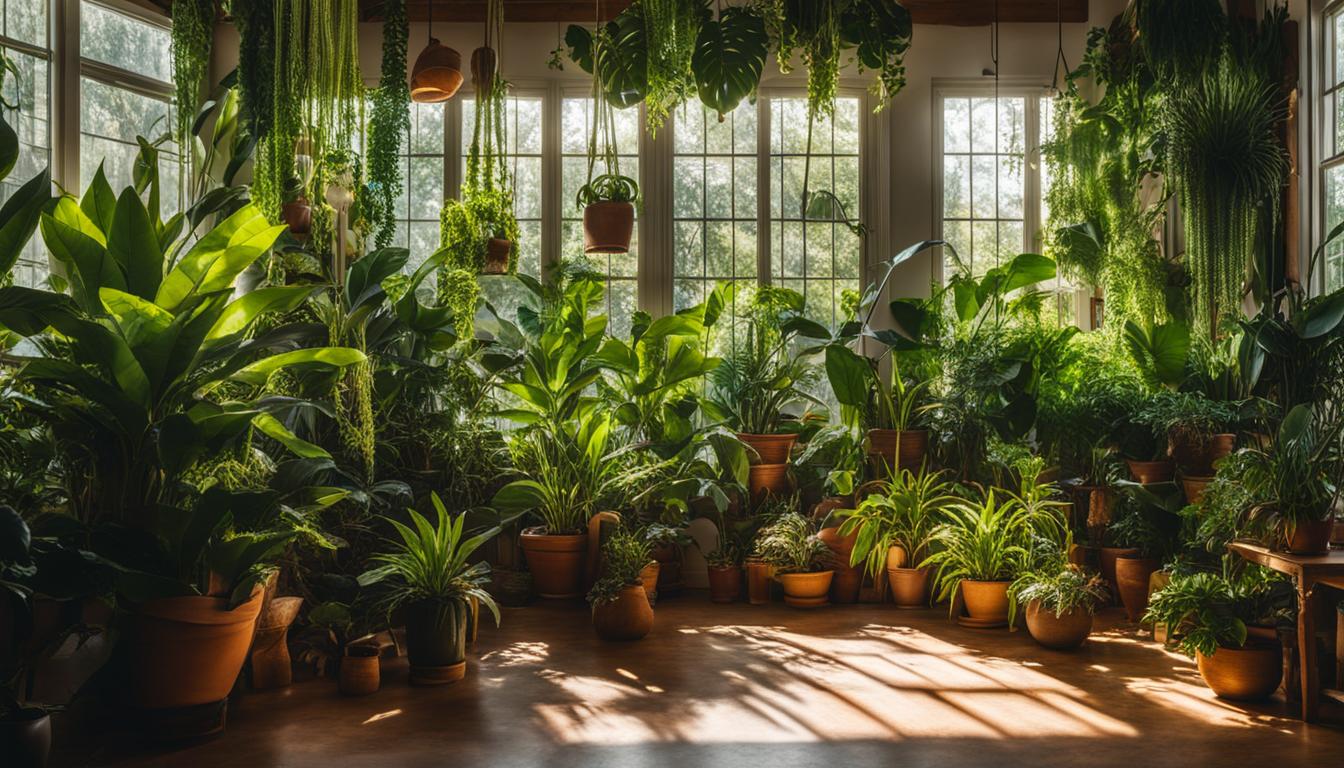
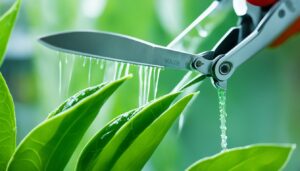
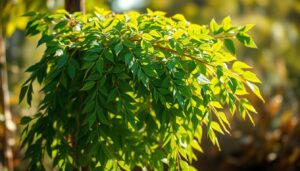
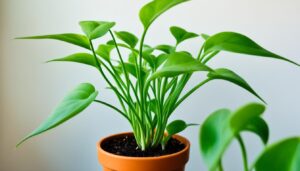
Pingback: Rubber Plant: The Resilient Houseplant That Can Withstand Cool Indoor Temperatures
Pingback: Philodendron, The Classic Low-Light Houseplant That’s Effortless to Grow
Pingback: Heartleaf Philodendron, The Romantic, Trailing Houseplant That’s Great for Beginners
Pingback: How to Grow a Bird of Paradise Indoors: Lighting, Watering, and Expert Tips
Pingback: Clivia, The Bold, Low-Maintenance Flowering Plant That Requires Minimal Care
Pingback: Bird of Paradise, The Exotic Indoor Plant That Brings a Tropical Vibe to Your Home